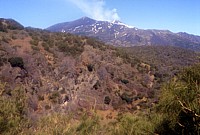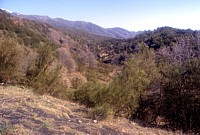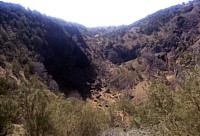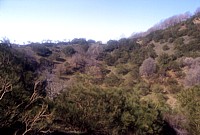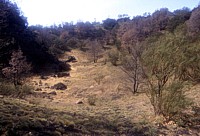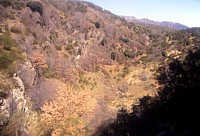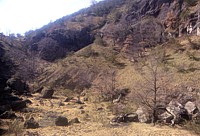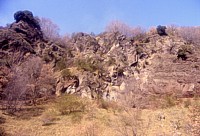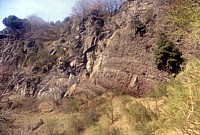| Etna
index |
||
| Geology | Geological history | Cones and craters |
| Eruptive characteristics | Eruptions before 1971 | Eruptions since 1971 |
| Etna and Man | References | Web sites |
| Weather forecasts | FAQ | Latest news |
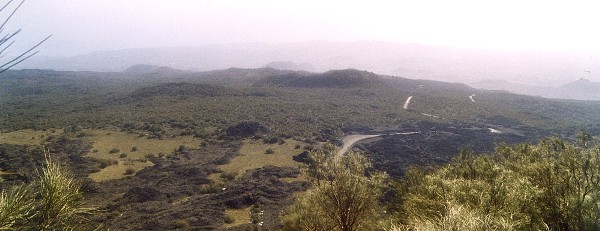 |
Monte
Salto del Cane is the low irregular cone seen in the center of
this photograph, taken from the summit of Monte
Serra Pizzuta Calvarina (about 1.5 km to the northwest) in
late January 2004. It essentially consists of two crescent-shaped
segments of its crater rim, on the west and east sides, with prominent
breaches on the north and south sides, and three deep craters
lying in the center. The crater rim is highest on the western
(near) side. The low rounded hill to the left of Monte Salto del
Cane is a large tumulus formed in the lava field of the long-lived,
voluminous 1634-1638 eruption; dark lava tongues in the foreground
are of the 1766 Monti Calcarazzi
eruption, while the still darker lavas at right were emitted in
1892 from the Monti Silvestri |
Mamma
Etna's countless children
Monte Salto del Cane
SSE flank, 15.035191° E, 37.680452° N
summit elevation: 1488 m (W crater rim)
![]()
Among
the numerous pyroclastic cones that lie on Etna's southern and southeastern
flanks, Monte Salto del Cane (which means "mountain of the descent
(or slope) of the dog", whatever the significance might be) is one
of the most peculiar for its deep craters and overall asymmetric morphology.
The cone itself is not very conspicuous, with its high western portion
rising only about 40 m above the surrounding terrain, but in contrast,
the floor of its largest, northern crater lies more than 110 m below the
west rim and is a popular destination for local hikers. This crater is
surrounded by impressive vertical walls showing outcrops of reddish scoriae
and bombs and lava flows. Differently from most of the other flank cones
of Etna, whose craters are relatively flat depressions on top of cones,
the main Monte Salto del Cane crater is an enormous hole in the ground,
where hikers find themselves in absolute silence and peace. A rough investigation
of the outcrops in the crater walls leads to the following interpretation
of the eruption that formed this crater: activity was initially characterized
by lava fountains emitted from a series of vents aligned on a N-S fissure,
resulting in the growth of pyroclastic cones, from which lava overflowed
in surges toward the east and south. At a lager stage the main vent seems
to have been filled by fluid lava, which continued to overflow on the
eastern side, while lava was probably also emitted from vents further
south. Toward the end, the large crater visible today was formed, either
by strong explosive (phreatomagmatic) activity, or by collapse. I have
not made any detailed study of the deposits capping the succession of
eruptive products of the Monte Salto del Cane eruption to ascertain which
of the two has actually been the case; however, the presence of small
currents of water in the crater walls indicate high groundwater levels
in the area. Monte Salto del Cane appears to be a fairly young feature,
although it is partly encircled by the large lava flow of 1634-1638, and
a small lobe of this lava entered into the northern crater.
I have passed dozens of time relatively close to Monte Salto del Cane
when driving up the road that is known as the "strada del Salto del
Cane" and leads from Nicolosi to the Rifugio Sapienza area, but my
first visit to this cone and its craters was made only on 16 March 2004.
All photos on this page except the one above were taken on that date.
Copyright © Boris Behncke, "Italy's Volcanoes: The Cradle of Volcanology"
Page set up on 11 March 2004, last modified on 22 March 2004

